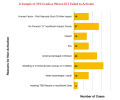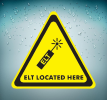If you're going to get into real trouble, it's most likely going to be during the takeoff or landing phases of flight - the phases when you won't be on flight following.
Flying VFR, I always file a VFR search and rescue flight plan, then request flight following in the air. I then terminate flight following when I approach the destination airport, then cancel the flight plan on the ground.
This is especially the case when I operate out of an uncontrolled (often rural) airport. If something happens during takeoff or landing, then I'm covered. I can be reasonably sure that someone will come out looking for me if something is amiss.
(For the same reason, I only cancel IFR on the ground when flying into an uncontrolled airport.)
With Foreflight, VFR flights plans are easy. File the flight plan from the app, activate it from the app, then cancel it from the app. (Similar products may do likewise.)
Speaking as an air search-and-rescue volunteer, when an aircraft goes missing, the more information the search coordinator and the search team have, the better. Flight following won't have a phone number for you, or the colour scheme of the missing aircraft. That would be on the flight plan.
Regarding ELTs, they are no doubt nice to have, but in the event of a crash, a light GA aircraft is most likely going to flip over onto its back - exactly where the ELT antenna is. It'll be sending a rescue signal directly into terra firma rather than the search party's homing device.
PLBs are great, but please carry them on your person - not in your flight bag. That way, you have them already if you must evacuate pronto.


